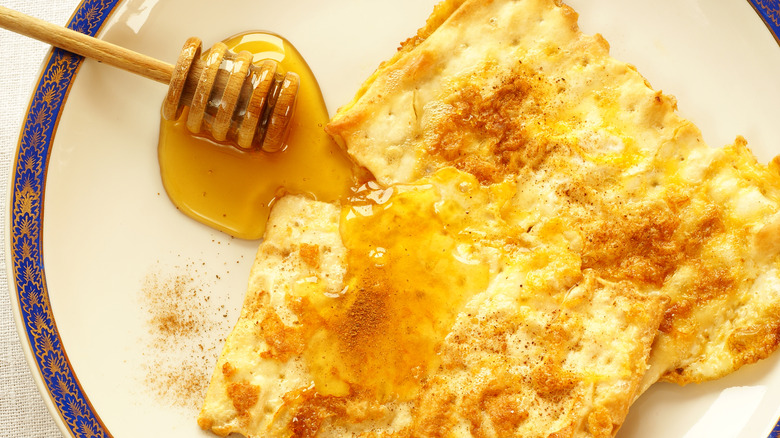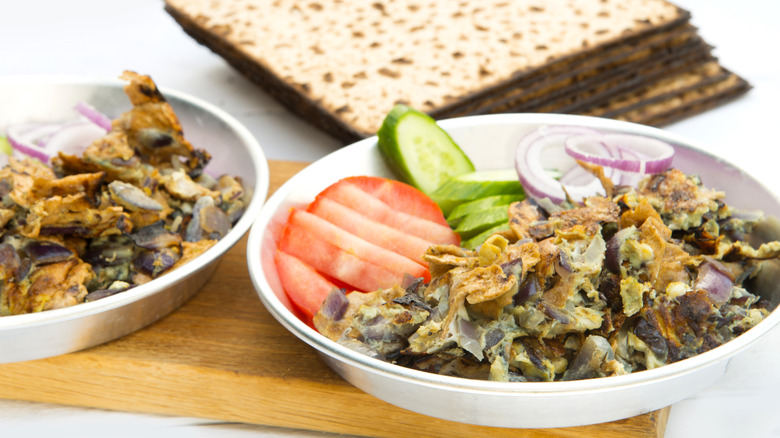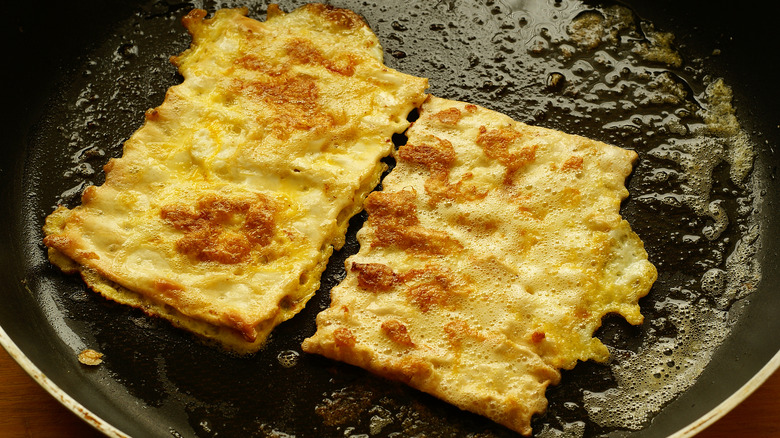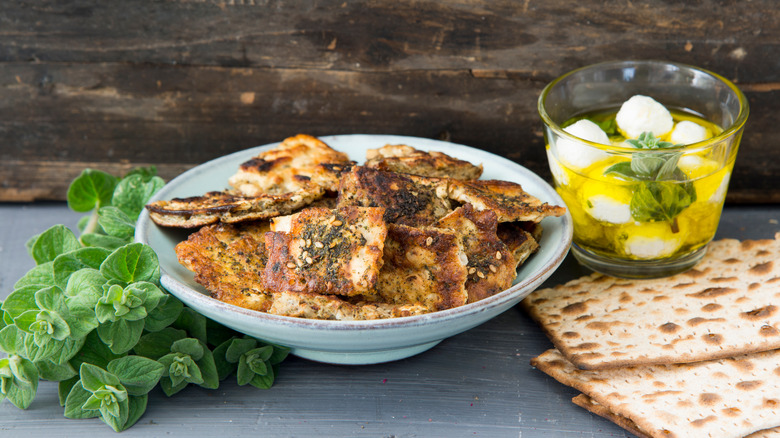The Reason Matzo Brei Is A Passover Staple
Have you ever heard of matzo? You most certainly have if you're Jewish, either observant or cultural. Matzo is a cracker-like, unleavened bread comprised of wheat flour and water eaten during Passover — the early spring holiday commemorating the ancient Jews' exodus from Egypt, where they were held as enslaved people.
A festive celebration reveling in the concept of freedom in all its forms, Passover is marked by enjoying a delicious dinner called the Seder. After reading through the story of Passover recorded by the document the Haggadah, families tuck into an expansive meal that includes traditional foods such as the fish quenelles called gefilte fish, matzo ball soup, beef brisket, and matzo heaped high with a sweet fruit chutney called haroset.
Matzo is a star of the Seder meal in multiple forms and is also eaten throughout the seven days of Passover. It is flat due to the Biblical story of the Jews fleeing Egypt and not having time to leaven their bread; as such, the cracker is a reminder of their sacrifice. And although many Jews like matzo, it can get tiresome when eaten plain — so many fry it into a tasty breakfast food called matzo brei.
What is matzo brei?
Eaten throughout Passover, matzo is not simply an option for observant Jews but an obligation. During this time, folks abstain from eating leavened bread, as well as other grains, including oats and rye. Doing so is a way to commemorate the sacrifices made by ancient Jews who fled Egypt in the 13th century B.C. and did not have time to make risen bread or properly prepared grains.
Due to this proscription, many Jews tire of basic matzo, turning it into matzo brei. This is a classic Jewish breakfast that's essentially French toast, just instead using matzo. In the dish, broken-up matzo is briefly soaked in water before being folded into eggs beaten with milk. The eggy matzo is then poured into a hot buttered or oiled skillet and fried up scramble-style or left in one big piece that's browned and then flipped over, like a pancake.
History of matzo brei
The history of matzo is lengthy, but it all starts with the second book of the Old Testament in Exodus, chapter 12, verse 15. It contains the line, "For seven days you are to eat matzah [sic] — on the first day remove the leaven from your houses. For whoever eats hametz (leavened bread) from the first to the seventh day is to be cut off from Israel." But for how long, approximately, have folks been eating matzo brei?
By all accounts, this cherished breakfast food is a more recent addition to the Jewish gastronomic canon. According to Gil Marks' "Encyclopedia of Jewish Food," the first written reference to water-soaked pan-fried matzos — without the egg — appeared in 1846 in "The Jewish Manual" under the name "Fried Matsos." Later, in 1889 and 1901, two American cookbooks featured recipes for matzo brei utilizing the egg soak — and the rest is history.
"Over the years, this dish has provided many an Ashkenazic Passover breakfast," Marks writes, referring to the Jewish heritage that traces to Europe, as opposed to the Middle East, "and, sometimes, also lunch and dinner."
Sweet vs. savory matzo brei
Why is matzo brei such an important Passover staple? Quite simply, it can be made in so many variations. Matzo brei lovers generally fall into two camps: Those who prefer sweet and those who like savory. The former camp might top their matzo brei with cinnamon sugar, honey, maple syrup, or fruit jam, while the latter can mix savory ingredients into their matzo brei or layer those ingredients on top.
Examples of savory options include folding caramelized onions and mushrooms into a matzo brei scramble or choosing the ritzier option of soft strips of smoked salmon. Fans of the pancake version might opt to top their cakes with chopped parsley, crème fraîche, and fresh lemon juice or go for slices of tomato and avocado. With all these options, matzo brei never gets old, making for a varied and delicious way to start each of the seven days of the holiday.



